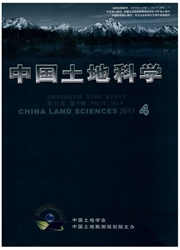

 中文摘要:
中文摘要:
研究目的:以兰州市为案例探讨低碳目标导向的土地利用结构优化途径。研究方法:模糊线性规划,多元线性回归分析,实证分析,对比分析。研究结果:从碳源和碳汇两方面构建模型显示碳蓄积最大化优化解与碳排放最小化优化解基本吻合。对兰州市2005年以及规划目标年的碳蓄积量和碳排放量进行估算,与原规划方案相比,优化方案到2020年兰州市年均碳蓄积量可增加14.7万t,年均碳排放量可减少18.69万t。通过多元线性回归分析,建设用地和林地与陆地生态系统碳循环关系最为密切,建设用地是主要的碳源,碳排放量约占97%,林地、耕地、牧草地是主要碳汇,碳蓄积量约占84%。研究结论:低碳目标导向的优化方案对于增汇减源的效果明显,可为规划方案今后的修编提供借鉴和补充,更好的实现土地资源合理利用和可持续发展的目的。
 英文摘要:
英文摘要:
The purpose of this paper is trying to put forward a new approach to optimize the land use structure to realize the low carbon target. Fuzzy linear programming, multiple regression analysis, empirical analyses and comparative analysis were employed in this paper. The results show that the objective to make carbon storage maximization , to make carbon emissions minimization is consistent. By estimating the carbon stock volume, carbon emissions, contrast the former planning with the optimization scheme based on low carbon target, the carbon stock volume will grow 147000 tons a year on average and the carbon emissions will reduce 186900 tons a year on average from 2005 to 2020 in l_anzhou. Construction land and forest land have the closest relations with the land ecological system carbon cycle by multiple regression analysis. The construction land is the main carbon source which composes of about 97%. Forest land, cultivated land and grassland are the main carbon sink which accounted for about 84% of all. Conclusion indicating, the two optimizing schemes have dramatically beneficial effect on increase carbon sink and reduce carbon source, which can provide reference and supplement for the revision later and realize the rational utilization of land resources and the sustainable development.
 同期刊论文项目
同期刊论文项目
 同项目期刊论文
同项目期刊论文
 期刊信息
期刊信息
